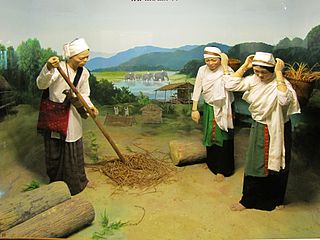
Madhya Pradesh is a state in central India. Its capital is Bhopal, and the largest city is Indore, with Jabalpur, Ujjain, Gwalior, Sagar, and Rewa being the other major cities. Madhya Pradesh is the second largest Indian state by area and the fifth largest state by population with over 72 million residents. It borders the states of Uttar Pradesh to the northeast, Chhattisgarh to the east, Maharashtra to the south, Gujarat to the west, and Rajasthan to the northwest.
Bundeli is an Indo-Aryan language spoken in the Bundelkhand region of central India. It belongs to the Central Indo-Ayran languages and is part of the Western Hindi subgroup.

Madhya Pradesh is a state of India. Music from the area includes rural folk and tribal music, ceremonial and ritual music and Indian classical music. Unlike in many parts of India, the people of Madhya Pradesh place few restrictions on who can sing which songs. With the exception of some ritualistic works, people sing songs from across ethnic and racial boundaries.

Folk music of Haryana has two main forms: classical folk music of Haryana and desi folk music of Haryana. They take the form of ballads and pangs of parting of lovers, valor and bravery, harvest and happiness.

Chhattisgarh is a state of India with strong tribal traditions of music and dance. The state of Chhattisgarh is best known for its deep roots in folk music, which originated from its long history of tribal involvement.

Tikamgarh district is one of the 52 districts of Madhya Pradesh state in central India. Tikamgarh town is the district headquarters. The district is part of Sagar Division.

Sheopur is a city in Madhya Pradesh state of central India. It is the administrative headquarters of Sheopur District. Sheopur is linked by narrow gauge rail to Gwalior(No longer in operation). The town is traditionally famous for its wood carving. Chambal River is just 25 km, which forms the boundary between Rajasthan and MP states.

Teej is the generic name for a number of Hindu festivals that are celebrated by women and girls. Haryali Teej and Hartalika Teej welcome the monsoon season and are celebrated primarily by girls and women, with singing, dancing, enjoyment and prayer rituals. The monsoon festivals of Teej are primarily dedicated to Parvati and her reunion with Lord Shiva. Women often fast in celebration of Teej.

The Tai Khamti, (Khamti: တဲး ၵံးတီႈ, or simply Khamti as they are also known, are a Tai ethnic group native to the Hkamti Long, Mogaung and Myitkyina regions of Kachin State as well as Hkamti District of Sagaing Division of Myanmar. In India, they are found in Namsai district and Changlang district of Arunachal Pradesh. Smaller numbers are present in Lakhimpur district, Dhemaji district and Munglang Khamti village in Tinsukia district of Assam and possibly in some parts of China. According to 2001 census of India, the Tai Khamtis have a population of 12,890. In Myanmar their total population is estimated at 200,000 people.

Tourism in Madhya Pradesh has been an attraction of India because of its location in the centre of the country. Madhya Pradesh has won Best Tourism State National award for 3 consecutive years i.e. 2017, 2016 and 2015.

The term Alha Khand is used to refer to poetic works in Hindi which consists of a number of ballads describing the brave acts of two 12th century Banaphar heroes, Alha and Udal, generals working for king Paramardi-Deva (Parmal) of Mahoba against Prithviraj Chauhan of Ajmer. The works has been entirely handed down by oral tradition and presently exists in many recensions, which differ from one another both in language and subject matter. The Bundeli, Bagheli, Awadhi, Bhojpuri, Maithili, and Kannauji recensions are the most well known among these.
Shankar Pratap Singh Bundela belongs to village Basari block Rajnagar, which was his former Estate under Madhya Pradesh. He is popularly known as Munna Raja.
Several folk dance forms evolved in different regions of Odisha, Odissi and Chhau being some popular forms. Sambalpuri dance is most popular dance of western Odisha.

The Mising, sometimes called Miri, are an indigenous community inhabiting parts of the Indian states of Assam and Arunachal Pradesh. They were also known as Miris in the past and still recognized as Miris in the Constitution of India. Misings are recognised as a Scheduled Tribe by the Indian government under the name 'Miri'. Their language, Mising, is part of the Tani branch of the Sino-Tibetan family.

Maach is a form of folk theatre from the Malwa region of the Indian state of Madhya Pradesh.
The National List of Intangible Cultural Heritage (ICH) of India is an attempt to recognize the diversity of Indian culture embedded in its intangible heritage. It aims to raise awareness about the various intangible cultural heritage elements from different states of India at national and international level and ensure their protection.
Deshraj Patairiya was an Indian folk singer from Bundelkhand. He is credited for popularizing Bundeli folk music across the country and internationally.
Rawal is an Indian community from Rajasthan and Gujarat. They are known as priests of devi temples and perform a form of dance known as Rammat during the worship. They were well respected and patronised by the Charans.
Ram Sahay Panday is a Rai dancer from Sagar in the Indian State of Madhya Pradesh. The Rai dance was traditionally associated with the Bedia community which itself was associated with flesh trade. In spite of the fact that he was not a member of the community, he devoted his whole life to the practice and performance of the Rai dance and to secure acceptance and respectability to the dance form. His untiring efforts helped obtain national and international recognition to this dance form.










